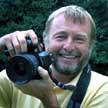I had a student with me the other day who was really keen to get to grips with the 'M' (Manual) exposure mode on his Nikon D60. She felt - with some justification - that having the ability to set the camera's exposure herself would enable her to get better photographs. Well, I explained that this would not necessarily follow as there are many other elements that go into creating a good picture. But I did tell her that an understanding of, and familiarity with, the manual settings on any camera would certainly mean that she would have more control and, eventually, she would be able to interpret a scene in her own way. This can often lead to better pictures.
The problem was that as she had kept the camera on a program mode for most of her photography in the past, she had little understanding of shutter speeds and aperture settings and the way they must work in harmony.
I tried very hard to explain in the simplest possible way that, for instance, an exposure of 1/125sec at f11 lets into the camera exactly the same amount of light as an exposure of 1/25osec at f8. This was part of the age-old problem that f numbers do not work logically for normal people. The fact that big apertures mean small numbers and small apertures mean big numbers is enough to confuse anyone.
And then I remembered a really old chestnut of an explanation...
With much theatrical acting, I placed an imaginary and very full bucket of water on the table in front of us. This, I said represented the correct amount of light to expose our picture correctly. The water was not sloshing out (over-exposed) nor was the bucket half full (under-exposed), it was full to the brim. Just right.
There were two ways of filling that bucket with a hose pipe (more acting) - I might use a big wide hose pipe (wide aperture) and fill the bucket very quickly (fast shutter speed). Or I could use a very small diameter hose pipe (small aperture) and trickle the water in very slowly (slow shutter speed).
Either way, I got the same amount of water in the bucket (or the same amount of light in the camera).
It worked like a charm - the penny dropped and from that moment my student understood a concept that had been totally confusing her. I do like simple.
I've posted a fair bit about using manual exposure in the past, so you could try these pages if you want to learn more...

No comments:
Post a Comment